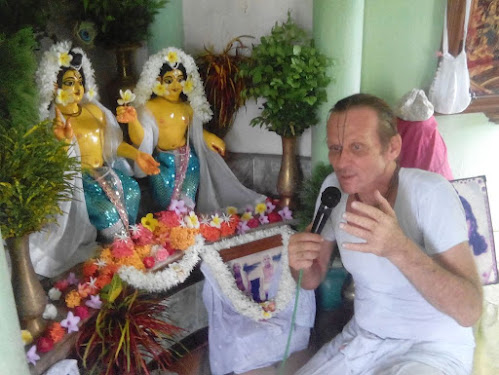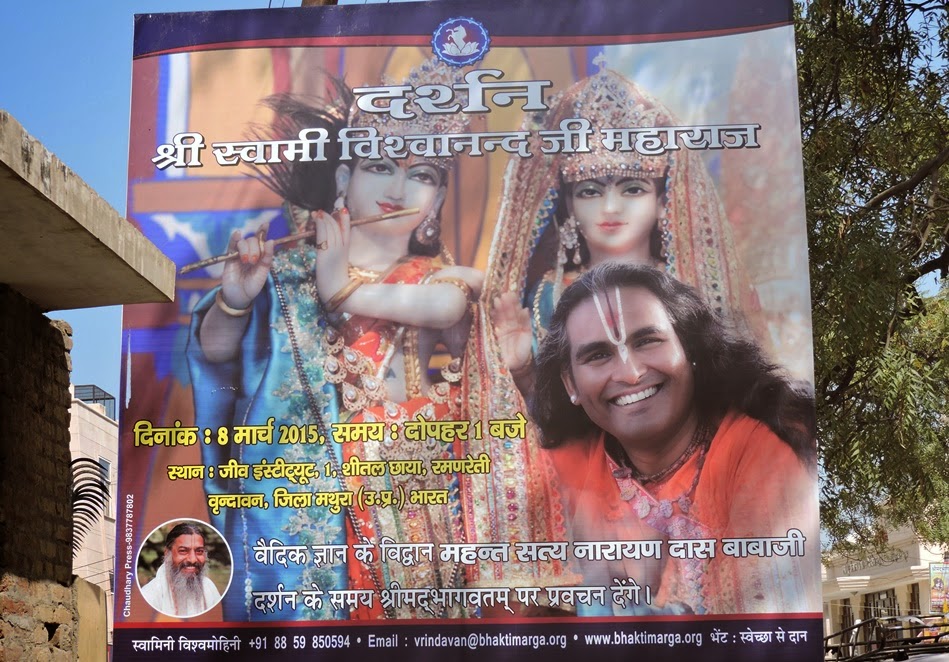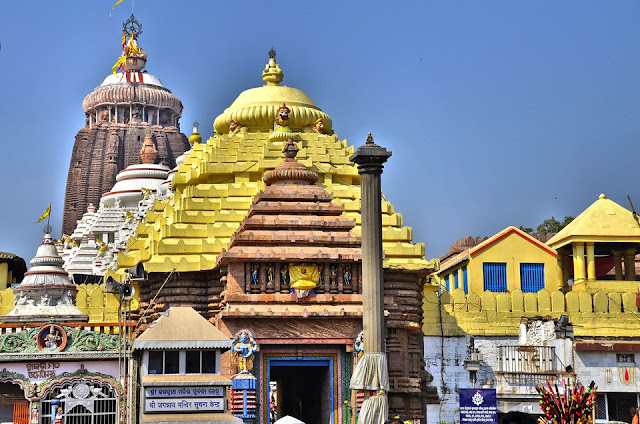Gadadhar Pran Das :: Sri Gaurasundar’s Main Activity (II)
Part Two: Sri Advaita Prabhu’s Madhura Upāsanā
Part I.
Vaishnavas wishing to learn about Gauranga’s original worship in Nabadwip are likely to be astonished at everything that Advaita Acharya’s Śrī Śrī Gaurāṅga-pratyaṅga-varṇanākhya-stava-rāja reveals about it. It is still quite surprising, however, that when Mahaprabhu’s preaching headquarters shifted from Nabadwip to Nilachala and then to Vrindavan after His departure, Advaita’s original mood of Gauranga worship was gradually forgotten. Another perspective on Gaura līlā, which came from Vrindavan, began to dominate. It was during this period that Krishnadāsa Kavirāja wrote Caitanya-caritāmrta on the basis of the siksha he received from Sanatan, Rupa, Raghunath Das, and his diksha guru, Raghunath Bhatta Goswami – all of whom had witnessed Chaitanya Mahaprabhu’s astonishing Radha bhāva līlās at Nilachala.
We should also mention that it was a full 100 years after Nabadwip’s most spectacular events secretly unfolded that the Caitanya-caritāmṛta was written. Yet Advaita’s Stavarāja reveals that just as the Vraja gopīs become spellbound by Krishna’s beauty and deeply yearn to perform His premamaya sevā, those very same feelings awakened in the Nabadwip bhaktas’ hearts upon viewing Gauranga.
Sri Gaurasundar’s Rūpa Mādhuri: His incredible bodily splendor
So if romantic desires became stirred in one’s heart upon seeing or hearing about Sri Bhagavān’s stunning beauty, then naturally a deep hankering to perform His rasarāja upāsanā will also awaken. When considering such worship with Gauranga, Advaita’s Stavarāja provides a wonderful guideline. So, on the one hand, just as the Vraja Goswamis are steeped in Gauranga’s Radha-bhāva feature, on the other, His Nabadwip bhaktas focus on His Rasarāja Sri Krishna mood. Here are a few examples:
sikhaṇḍāṅkita-gandhāḍhya puṣpa-gucchāvataṁsakam
“Hey Gaurasundar! As Krishna’s fine curling hair is bound in a topknot with a strand of pearls, adorned with fragrant flowers and topped with peacock feathers – so is Yours!” (Stavarāja 5)Yet upon seeing Gaura’s hair displayed so attractively, Lochan Das warns:
tabe satī kulavatī rākhte nāre kula
“Hey young housewives of Nadia – you’d better watch out! For if you look to Gaura’s curling hair and enchanting topknot, He’ll certainly steal your chastity!”Advaita goes on:
bhaṅgura-bhrū-latā-keli-jita-kāma-śarāsanam
prema-pravāha-madhura-raktotpala-vilocanam
tila-prasūna-susnigdha-nūtanāyata-nāsikam
“O Gaura kishora! Your forehead beams like a half-moon with intriguing tilaka designs painted over it. But aho! As Your dancing brows outmatch the might of Kāmadeva’s bow – a stream of madhura prema comes surging from Your red lotus eyes to devastate Your loved ones! So, won’t the elegant curve of Your shining raised nose pierce their hearts too – just like Cupid’s arrow?”Shrinivas Acharya’s poetic disciple, Sri Govinda Das [who wrote bhaja hure mana srinanda nandana], offers a similar testimony:
alakhita cita hāriyā lailo aruna nāyana bāne
“O sakhī! When looking from the corner of my eye – I saw Mother Sacī’s Son, Gauranga sundar. But O my! When no one was watching, He pierced me with His reddish glance to steal my heart!” – Pada-kalpa-toruAdvaita describes Gaurasundar’s immaculate limbs in this way, from His enchanting topknot to the bottom of His crimson, lotus feet. Narottama Das Thakur’s disciple Akinchan Das’ captures the Stavarāja’s essential message in a few words in his poetic Bengali translation:
“O Gaurasundar, how amazing! Every one of Your limbs appears like an ocean of romantic love!”So now we may wonder, why has the Creator made Gauranga so stunningly handsome? Advaita was already anticipating this question ), and so His next verse answers our query:
The Main Activity
sākṣāt līlā-tanuṁ keli-tanuṁ śṛṅgāra-vigraham
“Hey Madanmohan Gorā! Your glamorous prema-keli with Your beautiful consorts far outmatches the loving prowess of millions of Cupids! No wonder You personify śṛṅgāra (amorous love) – since Your transcendental body forms a beautiful abode for all of Your madhura prema affairs.” – verse 17.Here we come to Gaurasundar’s main activity and greatest source of pleasure. Advaita is referring to Prabhu’s prema-vilāsa with His bhaktas. Yet Vrindavan Das Thakur tells about these pastimes in his Caitanya-bhāgavata, too:
āchen gūḍha rūpe nijānande kutuhalī …
kāma-līlā karite yakhana icchā haya
lakṣārbuda vanitā se karena vijaya –
“Like Vanamālī Krishna, Gaurasundar enjoys confidential pleasure pastimes, but secretly. Because when desiring to relish madhura rasa (His kāma-līlā) Gaursasundar can easily defeat trillions of pretty damsels!” (1.12.232, 237)Advaita will now reveal more:
gadādhara-prema-bhāva-kalākrānta-manoratham
narahari-prema-rasāsvāda-vihvala-mānasam|
sarva-bhāgavatāhūta-kānta-bhāva-prakāśakam
prema-pradāna-lalita-dvibhujaṁ bhakta-vatsalam
“Hey Prānaballabha Gaura! The exciting bhāvas of the prema keli affairs You relish with Your rasikā nāgarīs are simply enchanting. Yet Gadādhar and Narahari’s exceptional prema, amorous talents and enchanting moods completely steal Your mind. What is more, at the slightest hint You warmly embrace Your Bhagavat bhaktas with Your lovely arms and become bhakta-vātsala for sharing Your splendid kānta-bhāva with every one of them!”Let’s stop to ponder for a moment: Now why has Advaita Acharya offered us such an intimate look into the līlā? For in His previous passages He has brought us to the highest peak in Gaudiya Vaishnava worship. So does He earnestly desire that Gauranga’s kānta-bhāva bhajan spread in Kali-yuga? Because if this is truly so, by His desire more and more people can become attracted to take it up. After due consideration, however, what other reason could prompt Him to present such an intimate and beautiful doctrine?
Advaita’s passages form a wonderful meditation. Because just as Radha, Krishna and the gopis submerge in the eternal bliss of their numerous prema-keli affairs – Gaurasundar’s pastimes with His glamorously beautiful nāgarīs are similarly exciting and pleasureful.
But there is a mystery unfolding here: Many of the nāgarīs to whom Advaita refers are Gauranga’s male bhaktas who have internal female svarūpas which can manfest at any time in the līlā. Of all of them, Gadādhar and Narahari are the foremost. This rasa-tattva is presented in Narahari Sarkar’s Kṛṣṇa-bhajanāmrta:
“Just as Sri Gauranga is the Source of all Avatāras, His divine and opulent consorts (the nāgarīs) expand from Gadādhar Pandit. So because Radha (and Her bhāva) are within Gadādhar, Gauranga enjoys vilāsa keli with Her. In other words, just as Radha and Krishna’s enchanting rati vilāsa and other keli vinoda pastimes take place in female and male forms, so do Gadādhar and Gauranga’s. Moreover, Gauranga’s conjugal affairs with the bhaktas’ (female) svarūpas are not only factual, but their very life!”This amazing passage from Narahari can help clear up the misconceptions that many people may have on this topic. For he states that just as the Vraja gopīs expand from Radha, the Nadia nāgarīs expand from Gauranga’s mūla śakti, Gadādhar Pandita. Hence anyone who reads it can discover a whole world of madhura prema bhajan in Mahaprabhu’s pastimes that they can not only take up but relish to their supreme spiritual satisfaction.
The Conclusion
The culminating siddhānta in Advaita’s Stavarāja runs as follows:
aśesa-rasika-sphūrjan-mauli-bhūṣaṇa-bhūṣaṇam
rasikānugata-snigdha-vadanābja-madhuvratam
śrīmad-dvija-kulottaṁsaṁ navadvīpa-vibhūṣaṇam
“Hey Gaura natarāja! Because limitless rasīkā nāgarīs worship You as the crown-jewel of their loving affection, You are Sri Nāgar siromani – the greatest romantic of all! Thus in pledging to loot the honey of all these rasikā followers, You fondly go on kissing their loving sweet lips! Even so, every brahmin and Nabadwip resident reveres You as the greatest member of their community.”Who could rightly say that our Gauranga Sundar isn’t a nāgara or flirtatious romantic? For then, wouldn’t they be overstepping Advaita’s conclusive verdict? Just consider the following: Since Advaita’s internal śakti Sita Thākurani is Yogamāyā, Who personally directs Prabhu’s parakīyā pastimes, Advaita is the first to know about them. Therefore, His madhura doctrine contains a form of bhajan that is universal. So why wouldn’t Gaurasundar wish to share this greatest source of pleasure with everyone?
The Author’s Submission
In summary, this essay has discussed basically three things:
1) that Sri Gaurasundar’s original worship in Nadia has somehow become lost in our world;
2) that in His form as Sri Nāgara śiromani – He is truly the greatest romantic among Sri Bhagavān’s limitless forms;
3) that every jīva is therefore eligible to perform Gauranga’s madhura upāsanā for attaining an intimate, loving relationship with Him.
Now, for us, doesn’t the last point sound the most meaningful? We are mentioning this because (knowingly or unknowingly) isn’t everyone searching for their ideal soul-mate, i.e., the person with whom we can deeply fall in love and share eternal happiness? For this primeval desire is spurred within everyone by the Paramātmā. In other words, as the ātma-ramaṇa, it is the Paramātmā who infuses our romantic feelings to unite with someone. But when conditioned by Māyā, we misdirect our inborn loving propensity, and become caught up in samsāra, the never ending cycle of birth and death. But just consider, this is why Sri Advaita’s doctrine is so invaluable. For it demonstrates how to direct our inborn loving propensity to Gaurasundar and become eternally happy.
We should emphasize that this doesn’t mean that the ānugatya-maya bhajan should be omitted. Rather, wouldn’t it be ideal to perform manjari bhāva and nāgarī bhāva bhajan together – since both sides of the coin are equally important and supremely worshipable? As Vasudeva Ghosh participates in these madhura pastimes, we end this essay with his following poem:
e tina bhuvane nāi emona nāgara
kulavatī satī rūpa dekhīyā mohita
guna suni torulatā hoy pulakito
sīla toru goli jāya khaga mrga kāde
nagarer nāgarī buka sthira nāhi bāde
surasiddha munir mona kore uccātāna
vāsughosa kohe gorā madan mohan –
Oh re ! My rasa-filled Gaura kishora! Since every young girl is going mad upon viewing Your beautiful form, You’re the Greatest Nāgar in the three worlds! Though in hearing Your glories even trees and creepers horripilate, stones melt, and the birds and deer cry! No wonder the nāgarīs’ hearts are swooning – since devatas, siddhas and sages lose their patience too! Vāsudeva Ghosh says: Gorā is Madan mohan!”A closer look into the process of Gaura’s Nadia kishora worship is coming in a comparative study with the Rūpānuga bhakti process of Vrindavan in our next volume entitled Sri Advaita’s Stavarāja, Part One.
The fallen sādhaka, Gadādhar prāna dāsa. Contact.
One can see more photographs of Gadai Gauranga Kunj here.





Comments